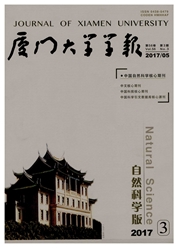

 中文摘要:
中文摘要:
附着变态是许多海洋无脊椎动物幼体生长发育的一个必经过程,是幼体性状消失而成体性状展开的关键阶段.报道了与附着变态密切相关的杂色鲍HdEGFl基因的克隆、序列分析及其时空表达模式.运用cDNA末端快速扩增技术(RACE)克隆了HdEGFl基因全长cDNA序列.该基因全长1239bp,含1个343个氨基酸残基的开放阅读框(ORF),推测的蛋白序列包含3个Ca2+结合类表皮生长因子(EGF—CA)结构域和1个血管性血友病因子(vWFA)结构域.通过序列相似性比较,确定其为新型表皮生长因子1(EGFl)相关蛋白.荧光定量PCR(qPCR)结果显示HdEGFl基因在幼体附着后的表达量比附着前任一时期均高19倍以上;全胚原位杂交(WMISH)结果显示HdEGFl基因集中表达在变态后幼体后消化道的表皮细胞.HdEGFl基因的这种时空表达模式表明HdEGFl受严格的时空调控,直接参与了附着后杂色鲍幼体后消化道的生长和细胞分化.推测HdEGFl蛋白与某未知的vWFA一结合蛋白一道调控着杂色鲍幼体后消化道的空间走向.因此,HdEGFl蛋白很可能在后肠的形态建成中起着非常核心的作用.本研究为贝类肠道形态建成机制的深入研究提供了切入点,HdEGFl基因可以作为重要的标志分子,用于深入研究肠道形态建成过程中的信号通路、细胞分化和细胞迁移.
 英文摘要:
英文摘要:
Settlement and metamorphosis are indispensable processes in the development of most marine invertebrate larvae, which are critical stages directly related to the larvae developing to adult. The present study identified the full-length eDNA sequence of a HdEGF1 gene from Haliotis diversicolor, the i 239 hp fulHength eDNA sequence was obtained through the technology of Rapid Amplification of eDNA Ends (RACE). This eDNA encodes a novel epidermal growth factor (EGF) related protein with 343 amino acid residues that contains three calcium-binding EGF-like domains (EGF-CA) and a yon willebrand factor type A domain (vWFA). Using quantitative PCR (qPCR) approach, the expression of the HdEGF1 gene was found to be 19 fold higher at metamorphosis stage than at any pre-settlement stages. In addition,the result of whole mount in situ hybridization (WMISH) indicated that the mR- NAs of the HdEGF1 gene were found to be accumulated in the epidermal cells of the primitive hindgut of postlarvae. The vWFA do- main analyses showed that the HdEGF1 protein might control the spatial distribution of the lower digestive tract via interaction with vWFA-binding proteins. The differences of HdEGF1 gene expression patterns before and after the settlement indicate that the devel- opment of the digestive tract downstream tissues is subjected to the strict regulation of settlement and metamorphosis. In conclusion, the HdEGF1 gene may play central roles in the development of lower digestive tract.
 同期刊论文项目
同期刊论文项目
 同项目期刊论文
同项目期刊论文
 期刊信息
期刊信息
